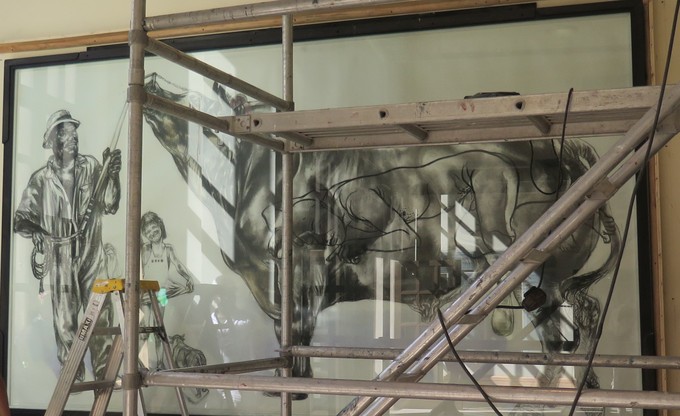The problem with art on UCT
And why covering up Diane Victor’s “Pasiphaë” is justified
This is a reply to an article that appeared on GroundUp on 8 April 2016 about the covering up of a prominent UCT artwork, and the comments by the artist in response.
In 2014 the then UCT SRC member and subsequent president Ramabina Mahapa wrote a series of articles which called into question the identity of UCT as an “Africa university”. Mr Mahapa asked “what is African about UCT?”. In his arguments showed that a problem exists at UCT: flagrant Eurocentrism dominates campus even though the university publicly proclaims itself to be Afrocentric. This problem, thanks to the likes of Mahapa and the Rhodes Must Fall (RMF) movement, has been put in the spotlight and called into question.
There are many others who have written about UCT’s Eurocentrism but for the purpose of this article I will focus on one particular article by Mr Mahapa which argued that there is nothing about UCT that fosters pride within black students due to the offensive artworks around campus. In the article he takes a journey across upper campus and notes these demeaning and offensive artworks that are on display. It is from this lens and that of the RMF’s call for decolonisation that my scrutiny of Diane Victor’s “Pasiphaë” and her response to it being covered up comes from.
To say the artwork is confusing would be an understatement. The artist herself has said the art draws from Greek mythology and due to it complex nature one would not clearly understand the art at first glance. As an appreciator of abstract art I would overlook this and seek the nuance in understanding it but the art’s striking use of a naked black man has been the subject of the criticism and confusion. And the artist’s explanation offered even less satisfaction on this. Her explanation all but exposed her lack of understanding and perspective for the reasons why the art is being covered up and this also highlighted why such art is not safe at UCT.
Now, it is important to understand what I mean by this. I am not talking about lack of safety in the form of the (inevitable) burning of the art that took place at the beginning of the year, but safety in the sense that the relevance of such artworks in spaces such as universities and beyond during the decolonisation project is under threat. As much as art is subjective and open to interpretation and also has the potential to offend, it is key to also interrogate its relevance and critique it at all times. Just as Mahapa argued that there is nothing that gives prides to black students at UCT the call to decolonise the university will mean having to deal with such issues as the offensive art displayed in contentious spaces on campus and even their use of black bodies for fetish consumption, amongst other factors.
It is also worth noting that the use of Black bodies as canvases of display and consumption is something the white gaze of artists and academics alike seem to not fully grasp, that it is steeped in a long and racist history, a history that offers the context for the critique of their work. The history of anti-blackness is deeply embedded in art and UCT and it would be very useful for Diane Victor to factor this in her equation before she calls the covering up of her art a “comical” knee-jerk reaction by the university. The process of constructing an inclusive university will include the re-imagining of space and covering up art that, through interrogation, is found to be offensive is one way of doing it and this is what I think Diane Victor does not get.
To suggest, as she does, that the critique of the art is “simplistic” is to devalue and even undermine the humanity of those who find it offensive and the work of those who call for the removal of similar artworks. Artists have to familiarise themselves with the changing landscape and imagination of universities. They need to understand that the complexities that come with this space will quickly render irrelevant the offensive and colonial artworks that stubbornly remain in full view of students grappling with a new sense of identity and belonging.
Views expressed are not necessarily GroundUp’s.
Support independent journalism
Donate using Payfast

Don't miss out on the latest news
We respect your privacy, and promise we won't spam you.
© 2016 GroundUp. 
This article is licensed under a Creative Commons Attribution-NoDerivatives 4.0 International License.
You may republish this article, so long as you credit the authors and GroundUp, and do not change the text. Please include a link back to the original article.

